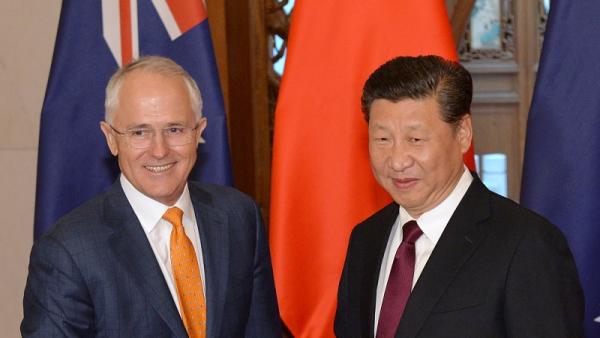
James Laurenceson, Deputy Director, Australia-China Relations Institute, University of Technology Sydney |
This article originally appeared in The Diplomat, February 9 2017.
Last year, defense hawks in the United States and Australia were handed a rude shock. A poll by the Sydney-based Lowy Institute revealed that 43 percent of Australians thought the country’s most important relationship was with the United States. The very same proportion said that it was with China.
Another poll by the U.S. Studies Center at the University of Sydney found that 48 percent of Australians thought the relationship with China should be stronger, compared with 32 percent who said the same about the United States
It is against this background that new U.S. President Donald Trump spoke to Australian Prime Minister Malcolm Turnbull last week.
After having had conversations with several other world leaders, including Russia’s Vladimir Putin, Trump reportedly told Turnbull that his was the “worst phone call by far.” As part of a discussion over a U.S.-Australia refugee resettlement plan, Trump accused Turnbull of trying to send the “next Boston bombers” to the United States.
Trump counsellor Kellyanne Conway then blamed Australia for leaking details of the conversation, despite the earliest reports citing White House sources, only later confirmed by Australian ones. In any case, Trump himself had fired off a tweet calling the refugee resettlement plan Turnbull had struck with the former Obama administration “a dumb deal.”
Many commentators declared China to be the big winner from the episode. But to focus only on the fallout of the phone call would be to miss a shift that was already underway.
In 2015, then-President Obama was reported to have called then-Prime Minister Tony Abbott, asking him to stay out of the China-sponsored Asian Infrastructure Investment Bank. After some initial equivocation, Abbott proceeded to lead Australia into the bank.
Later that year Obama chided Turnbull for not telling him ahead of time that the Australian government had approved a Chinese company’s bid to buy the Port of Darwin. Right next door is a facility that plays host to rotations of thousands of U.S. marines. Turnbull responded matter-of-factly, saying that Australia’s Department of Defense and intelligence agencies had looked carefully at the deal and found no problem.
In 2016, no fewer than three U.S. admirals suggested to Australia that it should join in running provocative freedom of navigation patrols within 12 nautical miles of Chinese-claimed features in the South China Sea. All were politely rebuffed.
This broader trend in Australian foreign policy choices reflects a basic fact: for all the continuing and genuine affection that Australia has for the United States and its critical importance as a security partner, a closer relationship with China is also firmly in Canberra’s national interest.
Last year China snapped up 27.5 percent of Australia’s exports, worth AU$85.9 billion. This was four times greater than that bought by the United States.
In terms of the bilateral trade balance, a favorite metric of Trump for determining the gains from trade, China delivered Australia its biggest surplus, worth AU$21.2 billion last year. In contrast, the United States handed Australia its biggest trade deficit, worth AU$25.4 billion.
And for a relatively small open economy like Australia, the prospect of what the OECD forecasts will be 850 million more middle class Chinese by 2030 is simply the brightest news on its economic horizon for everything from beef to tourism.
If Trump started a trade war with China, as it is looking increasingly likely that he will do, he would be endangering not only China’s economic transition, which in recent years has accounted for one-third of global growth, but Australia’s economic prosperity too.
A blanket tariff on Chinese imports, as Trump floated during the presidential election campaign period, would also put the United States in plain violation of World Trade Organization rules. Any moral authority it had to lecture China on abiding by international law in other contexts such as the South China Sea would evaporate. Canberra has loudly supported U.S. calls for China to embrace a rules-based international system. It would be left embarrassed in the face of its largest customer if the U.S. then tore up the rulebook on trade.
Trump has already withdrawn the United States from the Trans-Pacific Partnership (TPP), a rules-setting trade deal that the Obama administration had touted as the economic lynchpin of a pivot to Asia. Australia had welcomed the TPP and invested in it heavily.
Yet ultimately, Australia’s response to the deal’s torpedoing was predictably pragmatic. Foreign Minister Julie Bishop said Australia was disappointed but added that the vacuum created would most likely be filled by the China-championed Regional Comprehensive Economic Partnership and Australia would be part of it. What other response could Australia have had?
Australia’s longest-serving foreign minister, and now high commissioner to Britain, Alexander Downer, even suggested that perhaps a TPP without the United States might be salvaged if only China could be convinced to join.
This is the art of dealing with Australia that the Trump Administration will have to become accustomed: asking, or worse expecting, Canberra to make choices that put at risk a hugely beneficial relationship with China is unlikely to get a positive response. Ill-considered tweets won’t help either.
Author
Professor James Laurenceson is Deputy Director of the Australia-China Relations Institute (ACRI) at the University of Technology Sydney.


